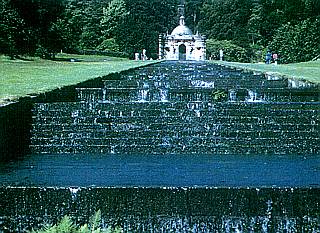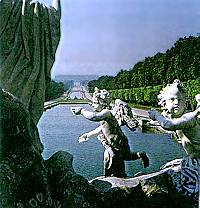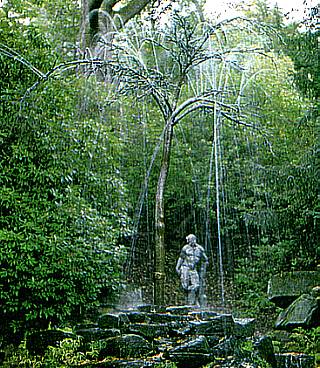|
Places where fountains can be fed by gravity have many advantages, not least the low maintenance and ease with which they can be built and commissioned. They are mainly found in towns and cities which are at the side of hills or mountains, where with the use of aqueducts, tunnels and pipes water can be funnelled to them. Barcelona, like Rome, has these advantages and the streets of Barcelona have hundreds of fountains as a consequence. In this country the preeminent water gardens are at Chatsworth in Derbyshire, where the best and grandest examples of gravity fed fountains can be seen. Chatsworth benefits from being below a large plateau of country from which water can be collected and stored before being fed through pipes to a wide range of water features in some charming gardens. The present gardens evolved since the 16th century under the directions of the descendants of Bess of Hardwick who had built the original house and gardens.  Figure 16. The Cascade at Chatsworth. Following the completion of the formal gardens at Verseilles(1668) the Cascade and French Classical garden became popular throughout Europe. Consequentially, the Cascade at Chatsworth (Figure 16.) was designed by a Grillet, a French pupil of the Celebrated Le Notre of Versailles fame. It was built for the first duke and finished in 1696, however it was rebuilt only 5 years later on a grander scale. The temple or cascade house was added in 1703 to the plans of Thomas Archer, the Warwickshire architect. (Figure 16.) The length of the paving stones over which the water flows and the numbers and widths of the 24 groups of steps are all different, so the sound of the falling water varies. At the base of the cascade the water disappears underground, passes through a pipe and works the sea horse fountain on the south lawn in front of the house, goes underground again to work the fountain in the west garden below the house, and is finally piped to the river. The cascade house and its watery forecourt contain a series of fountains and jets from which the cascade is fed. Even the dome of the house can be turned into a waterfall and the interior is pierced with holes to soak the surprised visitor. We are fortunate that the cascade at Chatsworth remains intact (Figure 16). Other examples of the grand cascade in the United Kingdom have succumbed to time, for example, at Stanway House in Gloucesteshire, where work has started on the restoration of another gravity fed cascade. Originally built in 1725-35 it was twice the length of the one at Chatsworth. When the French Classical garden fell out of fashion following the arrival of the English Landscape movement in the 18th century cascades and other expensive to maintain water features often fell into disrepair.
Various other delightful fountains and waterfalls are found at Chatsworth, these include the world highest gravity fed fountain. The Emperor Fountain at Chatsworth (Figure 1.) was commissioned by the 6th Duke who decided to outdo the Czars great fountain at Peterhof . He commissioned Sir Joseph Paxton to build the new feature. Paxton used a catchment area of 5 square miles and build the Emperor lakes holding some 50 million litres of water. Perhaps not large enough. Mr. John Oliver the Assistant Controller at Chatsworth explained that only 2% of the water available during the winter of 1993-4 was retained. The water enters the pipe having been through a mesh with a strain under 1 inch and is fed through a 15 inch internal diameter cast iron pipe 800 metres in length down some 120 metres to the fountain where at full running it expends 15000 litres of water per minute and has been recorded as achieving 296 feet. The Czar, after whom it was named, alas, never saw it. The fountain requires little maintenance. When a cast iron "pig" was run through the 15 inch pipe recently it was found to be entirely satisfactory. The estate plumber outlined the care with which the supply had to be started and stopped for fear of vibrations being sent up the pipe he also stressed the importance of quality rubber edged valves and pressure relief valves.
The ring pond contains a much gentler fountain where water spouts from the mouth of an anchient lead duck. NEXT: LIGHTING
|

http://www.gardening-uk.com/waterlands/
email: b.hirst@mac.com

